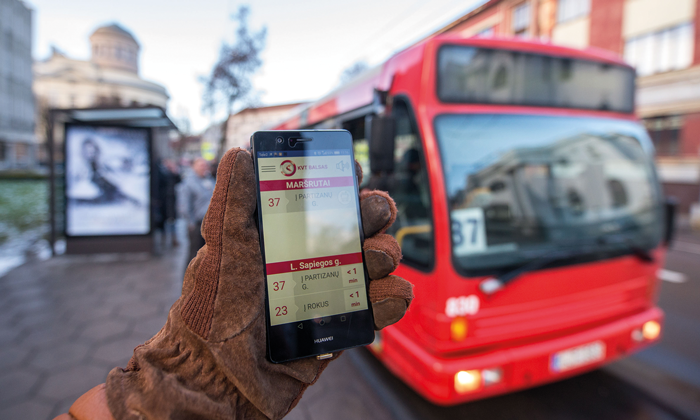KVT Voice: making accessibility more mobile
- Like
- Digg
- Del
- Tumblr
- VKontakte
- Buffer
- Love This
- Odnoklassniki
- Meneame
- Blogger
- Amazon
- Yahoo Mail
- Gmail
- AOL
- Newsvine
- HackerNews
- Evernote
- MySpace
- Mail.ru
- Viadeo
- Line
- Comments
- Yummly
- SMS
- Viber
- Telegram
- Subscribe
- Skype
- Facebook Messenger
- Kakao
- LiveJournal
- Yammer
- Edgar
- Fintel
- Mix
- Instapaper
- Copy Link
Posted: 21 August 2017 | Jim McGeever | No comments yet
Jim McGeever, Associate Consultant at LuxMobility, tells Eurotransport how a new mobile app from Kaunas Public Transport is changing the way in which those with a visual impairment can access and interact with the city’s public transport services.


At the start of 2017, the Kaunas city public transport bus company launched the ‘KVT Voice’ app (Kaunas Public Transport ‘Voice’) for blind and visually impaired persons. The development of the app – from conception, through various design and development phases, to full implementation – has taken less than a year.
This hardware and software solution provides blind and visually impaired users of public transport with more convenient and faster access to relevant information about services in real time. It is the first such device in Lithuania, and the inventor believes it may also be the first such mobile application internationally to provide an innovative interactive audio solution in real time to inform passengers of the arrival of public transport vehicles at bus stops.
Paulius Lengvenis – inventor, developer, and IT Manager at Kaunas Bus Company – says the inspiration for the idea came from a meeting he attended with heads of divisions and city council members in early 2016. At the meeting, the Vice Mayor explained that she was under pressure from leaders of the Blind and Visually Impaired Centre to substantially improve access to services. Lengvenis felt the suggestion of having loud speakers fixed to the front of buses to announce the bus number and route direction was a primitive solution in an age where most passengers now had smartphones. “About this time, I was aware of the potential of beacon technology being used in retail, so I thought, ‘why not use the same technology to solve this problem?’”
“With a visual impairment, it’s difficult to know when the vehicle arrives and which service it is. When looking to solve this problem, we discussed a number of options with blind and visually impaired users. Finally, we decided to develop software and hardware that enables real-time identification of the incoming bus and provides matching infor – mation about it. Such a use is the first of its kind I think,” said Lengvenis.
By downloading the free app ‘KVT Voice’, available on the Google Play store, blind and visually impaired passengers waiting at any bus stop will know what vehicle is arriving and which route it is taking. The app is also currently available with English as an optional second language for users, making public transport more accessible for foreign visitors and travellers to the city.
How does it work?
The main principle behind the device is relatively simple, allowing real-time information on routes (part of the city’s PIKAS traffic management system – a system developed within the CIVITAS I programme) to connect with all Kaunas public transport vehicles – 245 diesel buses and 140 trolley buses.
Each public transport vehicle is fitted with a small, cigarette-box sized beacon active tag, which in turn sends information to the user’s phone. Standing at the stop, the user’s mobile phone will ‘speak’, telling of the next arriving bus and stating its number and route destination. Once on board, all buses already have audio announcements of the next stop, so route management for blind and visually impaired passengers is made easier.
Using Bluetooth 4 Low Energy (BLE) technology, widely used in mobile devices, installation was straightforward and relatively inexpensive. Installation on all public transport vehicles cost approximately €40,000, with an additional cost of approximately €20,000 for development of the app. Low power consump -tion makes maintenance costs minimal too.
“We are pleased and proud that this innovation came from Kaunas city. It supports our commitment to providing for the needs of all of our citizens – especially those with disabilities. However, this app has shown us how we might now use the same technology to improve service provision of public transport for other groups of users too. We have an established system, we know it works, and we now hope to use it to further expand our knowledge,” said the Vice Mayor of Kaunas, Rasa Šnapštiene.
Further uses of the app for public transport may include bus stop and journey experience The scope for the app’s use could be expanded by the advent of beacon technology monitoring, allowing passengers to provide instant feedback on the condition of bus stops and the interiors and exteriors of vehicles, unruly behaviour of other passengers, and their driver’s driving skills. The potential is there to have full and active engagement with users of public transport services.
Citizen engagement in development
The Kaunas Centre for Blind and Visually Impaired lists around 700 members, whom have long been asking the city to provide improved public transport services that specifically cater for their needs. Members from the centre tested the app and provided user feedback to the technical team, with suggestions on how to improve it.
Saulius Kavaliauskas, Leader of the Centre’s volunteers, explains: “I, myself, am visually impaired. During the day, I can just about make out the numbers of buses coming to the stop. However, come twilight, I need assistance in defining which buses are arriving. Having this app to tell me which bus or trolleybus is coming and exactly when it will arrive is brilliant. Those who are completely blind, naturally, have even greater difficulties than I do. They need to be ready at all times, and without assistance can often only guess by the sound of the vehicle which bus has arrived.”
Future development and use
Having an open protocol means the range of opportunities for future use is unlimited. The development team have started working on possible additional uses. Up to 100 bus stops will have beacon technology fitted before the end of 2017, with another 100 bus stops fitted with beacons by the end of 2018.
Bus stop beacons will allow the city transport team to work closely with other city departments to provide more focused information about the interchange opportunities for passengers breaking their journey.
However, there is by far a greater, and wider potential for this technology to be used not only for public transport services, but also to promote the city’s cultural and commercial attractions. In the UK, two large retailers are already testing beacon technology as a means of providing customers with a fuller shopping experience, with large stores in Sweden likely to follow suit. The potential for Kaunas means that bus stops could provide customers within 50m of the stop with information regarding events, products, and prices for attractions that are nearby. Museums, art galleries, theatres, cinemas, shops, cafes, and public exhibitions, to name but a few citybased cultural and commercial opportunities, may look to beacon technology to increase customer interest in what’s going on around the city.
With the city already planning for its status as EU Capital of Culture in 2022, this technology has an enormous amount of potential to help the city grow and develop according to the needs and wishes of its citizens.
The city of Kaunas has been at the forefront of transport developments in Lithuania. In previous years, it’s been an active participant in high profile EU research and development projects, including the very first CIVITAS programme (2002-2006), as well as winning the prestigious CIVITAS Demonstration City Award. In recent years, the city has actively participated in a number of high profile, innovative EU projects developing mobility management measures in areas such as public transport, mobility planning, and road safety for schools.
Biography


Related topics
Passenger Accessibility, Passenger Experience
Issue
Issue 4 2017
Related modes
Bus & Coach, Trolleybus
Related organisations
LuxMobility
Related people
Jim McGeever, Paulius Lengvenis








